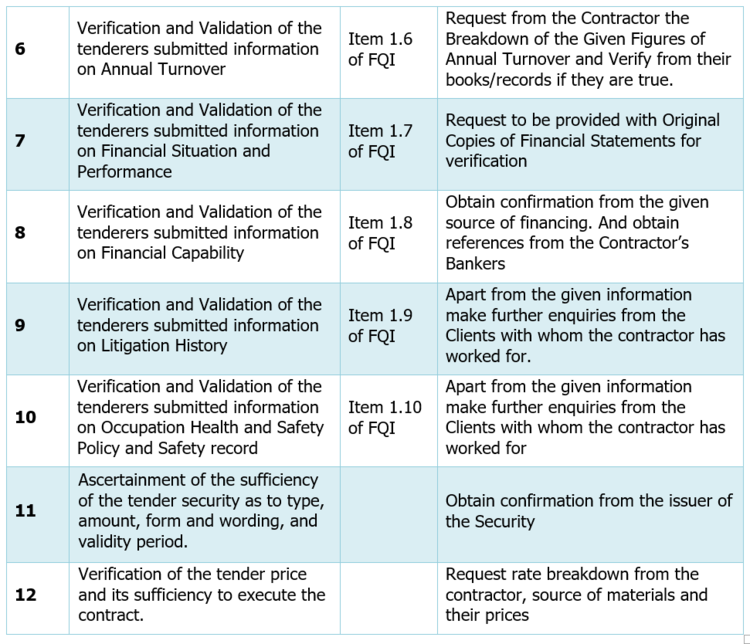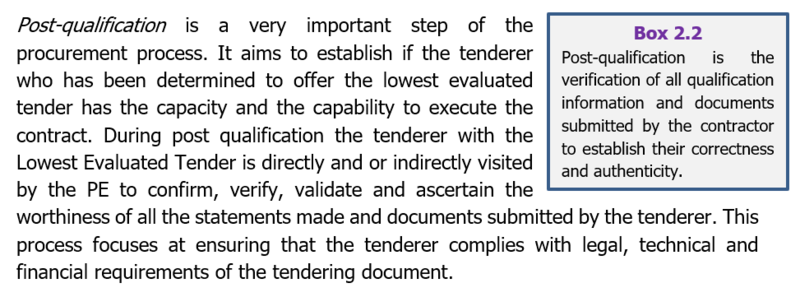Chapter Two: procurement process for water supply and sanitation projects
Contents
- 1 Introduction
- 2 Guiding Principles of Public Procurement in Tanzania
- 3 Fundamental Considerations for Procurement of a Contractor
- 4 Summary of the Procurement process
- 5 Guiding Principles of Public Procurement in Tanzania
- 6 Fundamental Considerations for Procurement of a Contractor
- 7 Summary of the Procurement process
- 8 Challenges with the Procurement Process
- 9 Post-Qualification and Issuance of Notice of Post-Disqualification
1 Introduction
Procurement is the acquisition of appropriate goods, works and/or services at the best possible total cost of ownership to meet the needs of a public entity in terms of quality, quantity, time and effective delivery.
The Public Procurement Act No. 7 of PPA 2011- Defines “Procurement” as “buying, purchasing, renting, leasing or otherwise acquiring any goods, works or services by a PE spending public funds on behalf of a ministry, department or regional administration of the Government or public body and includes all functions that pertain to the obtaining of any goods, works or services, including description of requirements, selection and invitation of tenderers, preparation, award and implementation of contracts.
As a function, Procurement should ensure acquisition of the right goods (equipment, materials, consumables), works (construction, repairs, rehabilitation), and services (individual consultants, consulting firms, training, workshops) required to satisfy certain needs at the right time, from the right contractor, in the right quantities, in the right quality and at the right price.
Public procurement enables Public Institutions to procure inputs which are vital for their operations and investments. The procured inputs can be in the form of physical infrastructure built or strengthened institutional and human capacities, both of which lay foundations for and promote national development.
In procurement terms and in line with the PPA 2011 and its Regulations, those inputs are generally grouped into four main categories as follows:
Works – which includes: (a) all works associated with the construction, reconstruction demolition, repair or renovation of a building, structure, road or airfield; and (b) any other civil works, such as site preparation, excavation, erection, building, installation of equipment or materials, decoration and finishing; (c) services which are tendered and contracted on the basis of performance of a measurable physical output such as transport of people or goods, drilling, mapping, photography or seismic investigations.
Generally contracts which include the provision of works and services shall be regarded as works contracts if the total value of the works is greater than the value of the service covered by the contract.
Goods: includes, Raw materials, products, equipment and other physical objects of every kind and description, whether in solid, liquid or gaseous form, electricity, intangible assets and intellectual property, as well as services incidental to the supply of the goods provided that the value of the services does not exceed the value of the goods themselves . Consultancy services: means activities of an intellectual and advisory nature that do not lead to a measurable physical output and include design, supervision, training, advisory, auditing, software development and similar services.
Non-consultancy service: means any object of procurement other than goods, works and consultancy services. It also includes services of a skilled or non-skilled nature, which is not a consultancy service and further includes, but is not limited to, cleaning, security, maintenance, and repair services.
2 Guiding Principles of Public Procurement in Tanzania
The Tanzania public procurement policies are based on the need to make the best possible use of public funds, whilst conducting all procurement with honesty and fairness. The overall objective of the public procurement system is to provide value for money to the Government by ensuring that public funds are spent in a transparent, efficient and fair manner. All public officers and members of TBs undertaking or approving procurement actions are guided by the following basic consideration of the public procurement policy in Tanzania; namely the need for economy and efficiency in the use of public funds and in the implementation of projects including the provision of related goods and services;
Economy: Procurement is a process that aims at providing the PE best value for the money spent. For complex purchases, value may imply more than just price. Other factors such as quality and delivery and appropriateness (just to mention a few) also need to be addressed. Moreover, lowest initial price may not equate to lowest cost over the operating life of the item procured. But the basic point is the same: the ultimate purpose of sound procurement is to obtain maximum value for money.
Efficiency: The best public procurement system is simple and swift, producing positive results without protracted delays. In addition, efficiency implies practicality, especially in terms of compatibility with the administrative resources and professional capabilities of the PE and the procurement personnel. The promotion of economy, efficiency and value for money practices is fundamental to any good public procurement system. Diligent application of principles value for money and economic efficiency can bring substantial savings of public funds. Savings can either be in the form of direct savings obtained through cheaper prices for goods or services or can be in the form of indirect savings obtained through provision of quality goods or services thus eliminating the need of redoing. PE are therefore, encouraged to adopt procurement practices that promote fair competition in all tenders, discourage the use of fake competition; and use methods of aggregation where appropriate in order to take advantage of economies of scale. The best interests of the PE, in providing all eligible suppliers , contractors, and service providers as per the requirements of the PPA 2011 equal opportunities to compete in the provision of goods, executing works or providing services;
Equal Opportunities: Good procurement is impartial, consistent, and therefore reliable. It offers all interested contractors, suppliers and consultants a level playing field on which to compete and thereby, directly expands the purchaser’s options and opportunities. Equal opportunities provides encouragement of national manufacturing, contracting and service industries;
Encouragement through Preference Schemes: Local manufacturing, contracting and service industries are given preference in tendering for public contracts so as to boost the national economy. Goods being procured are “manufactured goods” involving assembly, fabrication, processing etc., where a commercially-recognized final product is substantially different in basic characteristics of its components and raw materials. As for services, local service providers may either bid alone or in joint venture with fellow Tanzanian or foreign firms to qualify for the preference. This policy item emphasizes the importance of integrity, accountability, fairness and transparency in the procurement process.
Integrity and Accountability: Good procurement holds its practitioners responsible for enforcing and obeying the rules. It makes them subject to challenge and to sanction, if appropriate, for neglecting or bending those rules. Accountability is at once a key inducement to individual and institutional probity, a key deterrent to collusion and corruption, and a key prerequisite for procurement credibility. Ethical issues are amongst some of the obstacles in achieving value for money. People involved in procurement should ensure the following: avoidance of collusion, avoidance of conflict of interest, provision of equal opportunities, confidentiality and limited disclosure, avoidance of all corrupt practices in procurement, avoidance of all fraudulent practices in procurement, avoidance of obstruction and undue delays in procurement processing and exerting inappropriate influence on any procurement procedure.
Transparency: Good procurement should also be seen to be transparent and fair. The policy establishes and maintains rules and procedures that are accessible and unambiguous to all parties in the process. The procurement process should not only be fair, but should be seen to be fair.
Promotion of transparency in procurement can act as deterrence for corruption. PPA 2011 and its Regulations require that all PEs to the extent possible make their procurement proceedings transparent through public advertisement of tenders and disclosure of the procurement proceedings, a task which is assigned to PMUS. PEs are therefore, required to keep procurement records. To facilitate this PEs are required to maintain a complete record of the procurement proceedings, which may be made available to any person after the tender has been awarded with a requirement to avoid disclosure of proprietary commercial information.
A sound procurement system is one that combines all the above elements. The desired impact is to inspire the confidence and willingness-to-compete of well-qualified tenderers. This directly and concretely benefits the PE, the tenderers, the Government and other development partners.
A procurement system that does not embrace the above elements stimulates hesitation to compete, submission of inflated tenders containing risk premium, or submission of deflated tenders followed by delayed or defective performance during the contract implementation stage. A poor procurement system may also result in tenderers colluding to defraud the government and other procuring public bodies, bribery by frustrated or unscrupulous tenderers and consultants, bad value for those entities and betrayal and abuse of the public trust for personal gain.
3 Fundamental Considerations for Procurement of a Contractor
Contractor as used in this part means a firm/person who has been engaged by the Ministry and has a contract to supply goods or to carry out construction works or to provide non-consultancy services. Prior to the award of contract, contractors are referred to as tenderers.
It is in the interest of the Ministry that a contractor should have the capacity and capability to supply the goods or provide the intended services. Capacity relates to possession of the necessary resources- equipment, staff and finances while capability relates to possession of expertise and experience required to execute the contract.
3.1 Joint Venture (JV) Formation between Construction Organizations
Joint Venture is an association of firms that pool their resources and skills to undertake a large or complex contract in the role of “Contractor” with all firms (partners in the Joint venture (JV)) being legally liable, jointly and severally, for the execution of the contract in the event of a partner's withdrawal.
Joint ventures should be registered by Business Registration and Licensing Agency (BRELA) and the Contractors Registration Board (CRB). Most important factors considered during formation of JVs are the contract agreement, financial stability and commitment while key risks associated with JVs are cultural and social differences, delays in approvals and financial risks. The main challenges facing joint ventures are the identification of possible risks and joint venture agreement interpretation.
All individual firms and all partners of a joint venture should be requested to complete the information with regard to the management of Works contracts.
3.2 Procurement Process through TANePs System
TANePS (Tanzania National Electronic Procurement System) is a web-based, collaborative system, developed in accordance with the requirements of the public procurement laws and regulations to facilitate public procurement processes in Tanzania. It offers a secure, interactive, dynamic environment for carrying out procurement of all categories, complexity or value. (To access the system, go to www.taneps.go.tz)
4 Summary of the Procurement process
Tanzania’s procurement process is governed by the Public Procurement Act 2011 as amended in 2016, and Public Procurement Regulations 2013 as amended in 2016. The chart in Figure 2.1 summarizes the procurement process as required by the relevant legislation. Figure 2.2 has presented a comprehensive summary of the evaluation process for goods, works and non-consultancy services. Generally contracts which include the provision of works and services shall be regarded as works contracts if the total value of the works is greater than the value of the service covered by the contract.
Goods: includes, Raw materials, products, equipment and other physical objects of every kind and description, whether in solid, liquid or gaseous form, electricity, intangible assets and intellectual property, as well as services incidental to the supply of the goods provided that the value of the services does not exceed the value of the goods themselves . Consultancy services: means activities of an intellectual and advisory nature that do not lead to a measurable physical output and include design, supervision, training, advisory, auditing, software development and similar services.
Non-consultancy service: means any object of procurement other than goods, works and consultancy services. It also includes services of a skilled or non-skilled nature, which is not a consultancy service and further includes, but is not limited to, cleaning, security, maintenance, and repair services.
5 Guiding Principles of Public Procurement in Tanzania
The Tanzania public procurement policies are based on the need to make the best possible use of public funds, whilst conducting all procurement with honesty and fairness. The overall objective of the public procurement system is to provide value for money to the Government by ensuring that public funds are spent in a transparent, efficient and fair manner. All public officers and members of TBs undertaking or approving procurement actions are guided by the following basic consideration of the public procurement policy in Tanzania; namely the need for economy and efficiency in the use of public funds and in the implementation of projects including the provision of related goods and services;
Economy: Procurement is a process that aims at providing the PE best value for the money spent. For complex purchases, value may imply more than just price. Other factors such as quality and delivery and appropriateness (just to mention a few) also need to be addressed. Moreover, lowest initial price may not equate to lowest cost over the operating life of the item procured. But the basic point is the same: the ultimate purpose of sound procurement is to obtain maximum value for money.
Efficiency: The best public procurement system is simple and swift, producing positive results without protracted delays. In addition, efficiency implies practicality, especially in terms of compatibility with the administrative resources and professional capabilities of the PE and the procurement personnel. The promotion of economy, efficiency and value for money practices is fundamental to any good public procurement system. Diligent application of principles value for money and economic efficiency can bring substantial savings of public funds. Savings can either be in the form of direct savings obtained through cheaper prices for goods or services or can be in the form of indirect savings obtained through provision of quality goods or services thus eliminating the need of redoing. PE are therefore, encouraged to adopt procurement practices that promote fair competition in all tenders, discourage the use of fake competition; and use methods of aggregation where appropriate in order to take advantage of economies of scale. The best interests of the PE, in providing all eligible suppliers , contractors, and service providers as per the requirements of the PPA 2011 equal opportunities to compete in the provision of goods, executing works or providing services;
Equal Opportunities: Good procurement is impartial, consistent, and therefore reliable. It offers all interested contractors, suppliers and consultants a level playing field on which to compete and thereby, directly expands the purchaser’s options and opportunities. Equal opportunities provides encouragement of national manufacturing, contracting and service industries;
Encouragement through Preference Schemes: Local manufacturing, contracting and service industries are given preference in tendering for public contracts so as to boost the national economy. Goods being procured are “manufactured goods” involving assembly, fabrication, processing etc., where a commercially-recognized final product is substantially different in basic characteristics of its components and raw materials. As for services, local service providers may either bid alone or in joint venture with fellow Tanzanian or foreign firms to qualify for the preference. This policy item emphasizes the importance of integrity, accountability, fairness and transparency in the procurement process.
Integrity and Accountability: Good procurement holds its practitioners responsible for enforcing and obeying the rules. It makes them subject to challenge and to sanction, if appropriate, for neglecting or bending those rules. Accountability is at once a key inducement to individual and institutional probity, a key deterrent to collusion and corruption, and a key prerequisite for procurement credibility. Ethical issues are amongst some of the obstacles in achieving value for money. People involved in procurement should ensure the following: avoidance of collusion, avoidance of conflict of interest, provision of equal opportunities, confidentiality and limited disclosure, avoidance of all corrupt practices in procurement, avoidance of all fraudulent practices in procurement, avoidance of obstruction and undue delays in procurement processing and exerting inappropriate influence on any procurement procedure.
Transparency: Good procurement should also be seen to be transparent and fair. The policy establishes and maintains rules and procedures that are accessible and unambiguous to all parties in the process. The procurement process should not only be fair, but should be seen to be fair.
Promotion of transparency in procurement can act as deterrence for corruption. PPA 2011 and its Regulations require that all PEs to the extent possible make their procurement proceedings transparent through public advertisement of tenders and disclosure of the procurement proceedings, a task which is assigned to PMUS. PEs are therefore, required to keep procurement records. To facilitate this PEs are required to maintain a complete record of the procurement proceedings, which may be made available to any person after the tender has been awarded with a requirement to avoid disclosure of proprietary commercial information.
A sound procurement system is one that combines all the above elements. The desired impact is to inspire the confidence and willingness-to-compete of well-qualified tenderers. This directly and concretely benefits the PE, the tenderers, the Government and other development partners.
A procurement system that does not embrace the above elements stimulates hesitation to compete, submission of inflated tenders containing risk premium, or submission of deflated tenders followed by delayed or defective performance during the contract implementation stage. A poor procurement system may also result in tenderers colluding to defraud the government and other procuring public bodies, bribery by frustrated or unscrupulous tenderers and consultants, bad value for those entities and betrayal and abuse of the public trust for personal gain.
6 Fundamental Considerations for Procurement of a Contractor
Contractor as used in this part means a firm/person who has been engaged by the Ministry and has a contract to supply goods or to carry out construction works or to provide non-consultancy services. Prior to the award of contract, contractors are referred to as tenderers.
It is in the interest of the Ministry that a contractor should have the capacity and capability to supply the goods or provide the intended services. Capacity relates to possession of the necessary resources- equipment, staff and finances while capability relates to possession of expertise and experience required to execute the contract.
6.1 Joint Venture (JV) Formation between Construction Organizations
Joint Venture is an association of firms that pool their resources and skills to undertake a large or complex contract in the role of “Contractor” with all firms (partners in the Joint venture (JV)) being legally liable, jointly and severally, for the execution of the contract in the event of a partner's withdrawal.
Joint ventures should be registered by Business Registration and Licensing Agency (BRELA) and the Contractors Registration Board (CRB). Most important factors considered during formation of JVs are the contract agreement, financial stability and commitment while key risks associated with JVs are cultural and social differences, delays in approvals and financial risks. The main challenges facing joint ventures are the identification of possible risks and joint venture agreement interpretation.
All individual firms and all partners of a joint venture should be requested to complete the information with regard to the management of Works contracts.
6.2 Procurement Process through TANePs System
TANePS (Tanzania National Electronic Procurement System) is a web-based, collaborative system, developed in accordance with the requirements of the public procurement laws and regulations to facilitate public procurement processes in Tanzania. It offers a secure, interactive, dynamic environment for carrying out procurement of all categories, complexity or value. (To access the system, go to www.taneps.go.tz)
7 Summary of the Procurement process
Tanzania’s procurement process is governed by the Public Procurement Act 2011 as amended in 2016, and Public Procurement Regulations 2013 as amended in 2016. The chart in Figure 2.1 summarizes the procurement process as required by the relevant legislation. Figure 2.2 has presented a comprehensive summary of the evaluation process for goods, works and non-consultancy services.
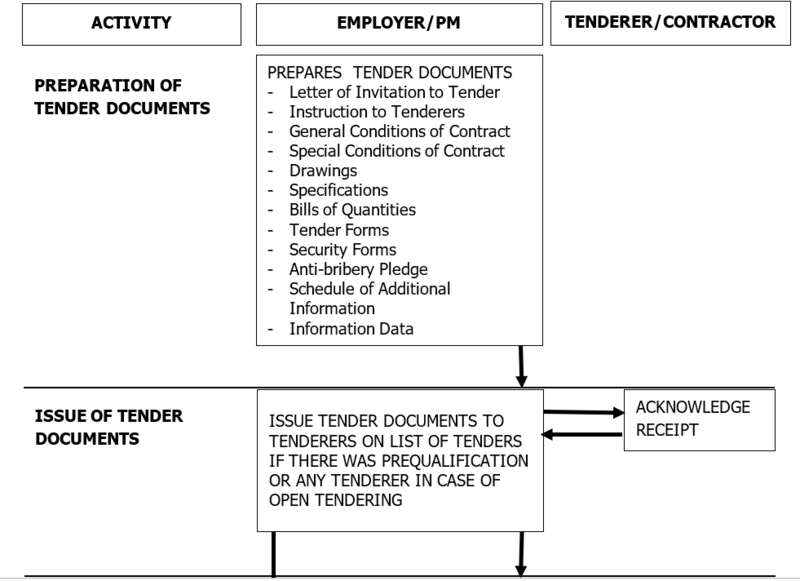
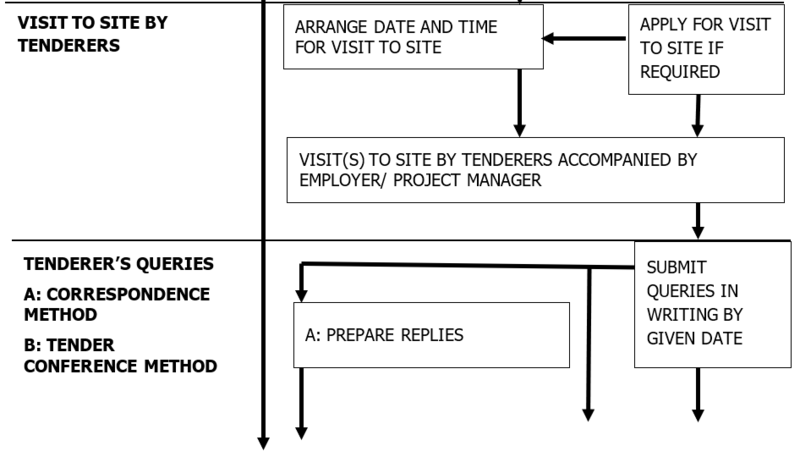

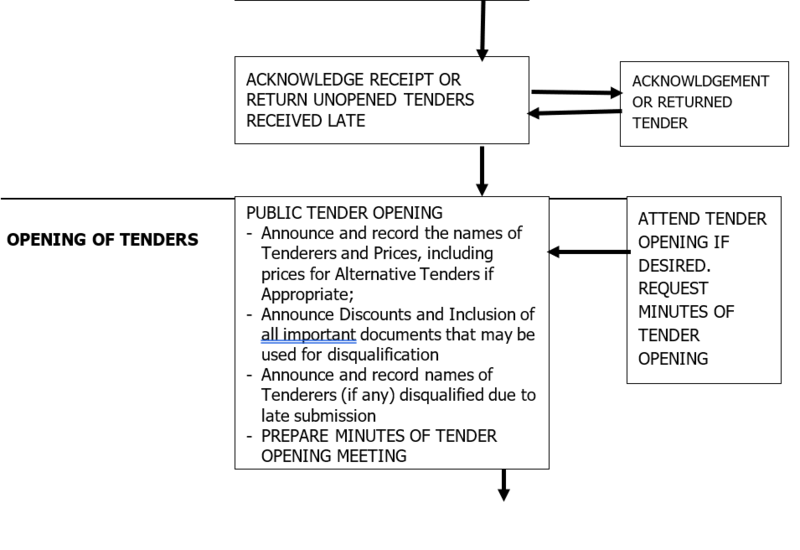
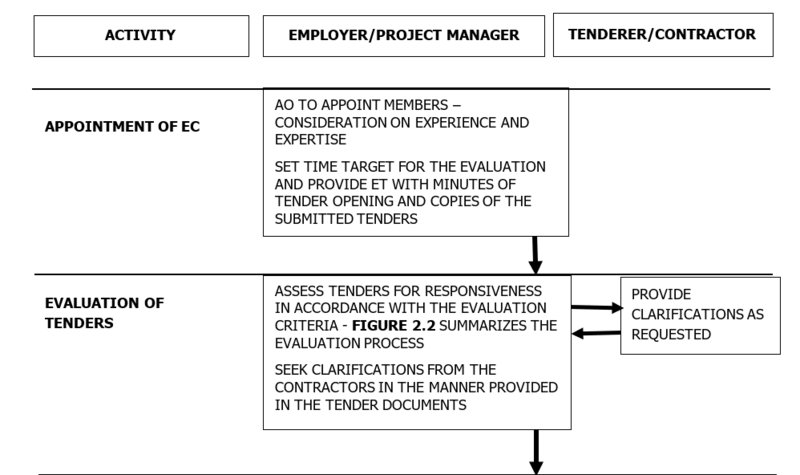
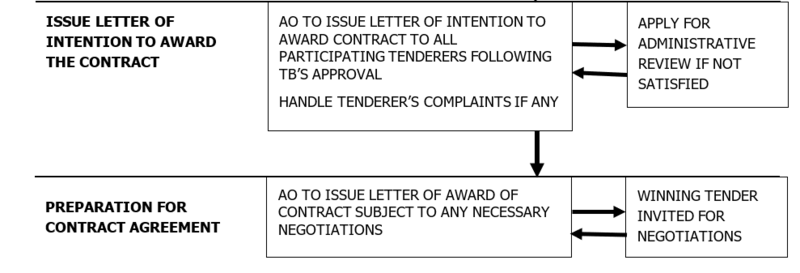
Figure 2.1 Flow Chart Summarizing the Procurement Process for Works
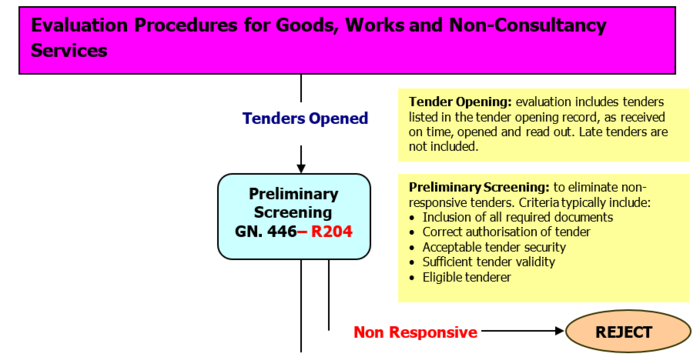

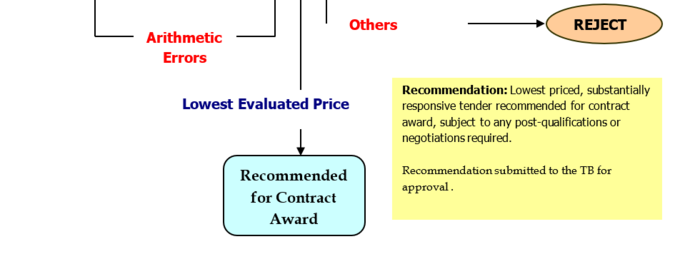
Figure 2.2: Evaluation Process for Goods, Works and Non-Consultancy Services
8 Challenges with the Procurement Process
There are many complaints lodged relating to the long time taken to carry out procurement of a contractor from the point of initiation of requirements to the point of award of contract and that the outcome of that lengthy process leads to obtaining a contractor who lacks capacity and capability to execute the contract.

Another major challenge is the quality of the prepared tender documents. Non- completeness of the tender documents not only affects the procurement process, but also has a downstream effect in the implementation of contract leading to many variations which result in cost overruns and delay in the completion of the project.
The following is a Checklist of important issues to consider in the procurement process in order to ensure the process is efficient and that a contractor with capacity and capability to execute the contract is obtained:
• Ensure that the user’s requirements are clearly established and properly translated into tender documents – namely the Drawings, Specifications and Bills of Quantities (BOQ). Omissions and mistakes can have serious consequences in the tender process as they invite many queries and requests for clarifications from tenderers and sometimes necessitate the extension of time for submission of tenders. If the omissions are not picked up by the tenderers during the tender process , they will result into variations and extension of time during contract execution.
____________________________________________
2Some loop-hole seeking contractors use the mistakes and omissions in the tender documents to benefit during contract execution through claims.
• Ensure that a proper estimate is prepared for the project. This is very crucial as it will form a deciding factor on whether submitted tenders are very expensive or abnormally too low and therefore justify rejection of such tenders. An estimate is prepared by costing the prepared BOQ using current market rates for executing various activities as presented in the BOQ and allowing a reasonable margin of profit for the contractor.
• Based on the prepared tender documents and the estimate, both of which gives the scope and cost of the project, determine eligibility and qualification requirements for the tenderer. Remember that very stringent eligibility and qualification requirements will make the procurement process non-competitive as very few tenderers may qualify to participate. Less stringent requirements may lead into obtaining a contractor who lacks capacity and capability to execute the contract.
• Fix reasonable time for the preparation and submission of tenders by tenderers.- PEs are expected to fix a realistic tender period depending on the size and complexity of procurement- they should make a realistic estimate of time required for tenderers to prepare and submit a competitive tender. Unrealistic tender period results into getting non-responsive tenders and therefore necessitating re- tendering, or the need to extend the tender period thus leading to delay the tender process. o For example a tender period of 14 days specified in the PPR 2013 for submission of tenders by tenderers using National Competitive Tendering Method may not be enough for big tenders. The Ministry should consider setting tender period based on the magnitude of the tender, for example for Tenders between Tshs 200 to 500 million, a tender period of 14 days be provided, and this period could be increased by seven days whenever works increase by one billion i.e. 21 days for tenders between Tshs 500 to 1,500 mil, 28 days for tenders between 1,500 to 3,000 mil. PPRA may be requested to issue guidelines on how to fix tender period.
• Provide all the information under your possession that may assist the tenderers to prepare responsive and competitive tenders. Such information may include soil investigation reports, weather reports etc. Given the short time given to tenderers to prepare their tenders it would be impossible for them to get most of the information.
• Ensure that the evaluation criteria are explicitly stated in the tender documents. This enables tenderers understand how their tenders will be evaluated and may also enable them to make a decision on whether to or not to submit a tender.
• Respond to all requests for clarification from the tenderers in a timely manner, and consider the time and effort required by the tenderer to accommodate the given clarification in their tender and its effect on the tender period. Where it is determined that to accommodate a clarification requires more effort and time, the PE should consider extending the tender period subject to the approval of the TB.
• Ensure that opening of tenders is done properly by ensuring that all the important information, particularly the discounts and those that can be used to disqualify a tenderer are read out during the opening. Minutes should be prepared that reflect what transpired during the tender opening process as these may be useful in situation where there are complaints from the tenderers.
• Ensure that the appointment of Evaluation Committee (EC) takes place in a timely manner, possibly before or on the date of tender opening, and that the appointed members have experience and qualifications fit for the evaluation of the tender in question. The quality of the decision of the TB is dependent on the quality of the evaluation report which is in turn dependent on the quality of the EC.
• Ensure that evaluation of tenders is done properly in conformity with the evaluation criteria contained in the tender documents. It should be noted that the role of the EC is to evaluate tenders in accordance with the evaluation criteria contained in the tender document. Therefore, before commencing with evaluation of any submitted tender the EC will need to go through the tender document issued to tenderers to familiarize themselves with the evaluation criteria. The actual evaluation process should start only when everybody in the EC has understood the evaluation criteria.
• In case there are complaints from tenderers, whether submitted informally or formally as application for administrative review, they should be properly handled by the Accounting Officer (AO). Depending on the complexity of the tender the AO may wish to appoint a review panel as allowed for in the PPA Act 2011. Failure to handle a tenderer’s complaints internally may lead into referring them to the Public Procurement Appeals Authority or High Court and therefore lead to delays in the procurement process. • Ensure that proper and adequate Post-Qualification is carried out to the lowest evaluated tenderer. Post-qualification is covered in detail in Section 2.5.
• Finally, ensure that proper negotiation is made with the tenderer recommended for the award of the contract. Areas of negotiation are required to be identified by the EC who had the opportunity to read thoroughly the tender submitted by recommended tenderer for award of the contract. All agreements reached out during the negotiations should be incorporated in the relevant contract documents.
The above list of issues/actions, if taken care of will enable the Ministry to overcome some of the potential problems encountered in the procurement process.
9 Post-Qualification and Issuance of Notice of Post-Disqualification
9.1 Purpose of Post-Qualification
Legal requirements involves the verification, validation and ascertaining of the ownership of the company, credibility and integrity of shareholders and directors, incorporation of the company, compliance to tax obligations and whether the required licenses are in place and properly procured.
Technical requirements involve validation, verification and ascertaining the correctness of the documents submitted by a tenderer to prove the quality of the goods and services offered. This may involves: (a) Verification and validation of the tenderer’s stated competence and experience; (b) Verification and/or inspection and testing of the products, after sales maintenance convenience and affordability and capabilities. In applicable cases physical inspection of plants, sites or places of business to determine production capacity is conducted as well; and (c) Ascertainment of the authenticity of the tender security and the tender validity period.
Financial requirements involve verification, validation and ascertaining the tender price proposal of the tenderer, its financial contracting capacity, and the required bank commitment to provide a credit line to the tenderer. This is to ensure that the tenderer can sustain the operating cash flow of the contract.
2.6.2 Forms of Post Qualification
Post qualification can take diverse ways to be accomplished provided that the end result is getting correct information confirming the criteria of the prospecting tenderer. Criteria for post qualification will be confined to those spelt out in the tendering documents supplied to tenderers. There are mainly two common forms of post qualification:
• Visiting the Tenderer’s Business: This is the place where most resources of the tenderer, including the human resources, offices, and equipment are expected to be found. Visiting will establish whether the tenderer is a brief case company or an authentic company with offices. Also the resources will be seen and assessed. The visiting can also be made to tenderers sites or places of business.
• Independent Reference: This entails seeking comments, observations, reference from other organizations that also had similar transactions with the tenderer. This is done by the PE writing directly to those organizations inquiring for some particulars of the tenderer. In all these two forms, the main agenda is to let the tenderer demonstrate again and much more practically that he is worth the criteria set for the tender.
9.2 Guidance on Notification of Post-disqualified Tenderers
The following guidance is provided to assist in carrying out post-qualification:
(a)The TB is required to verify, validate, and ascertain the genuineness, validity, and accuracy of the legal, technical, and financial documents submitted by the tenderer with the Lowest Evaluated Tender using a non-discretionary “pass/fail” criterion in order to ensure that such a tenderer has passed all the requirements and conditions specified in the Tendering Documents.
(b)It is recommended that post-qualification be conducted for a tenderer whose tender has been approved by the TB to be the lowest evaluated. Members of the Post-qualification Team preferably need to be members of the EC.
(c)The post-qualification shall include, among others, the Items included in Table 2.1, whenever applicable. All enquiries should be made in writing or electronic forms that provide a record of the content of the communication made. All the communications made shall be annexed to the Post-Qualification report.
(d)If the TB determines that the tenderer with the Lowest Evaluated Tender fails to comply with the criteria for post-qualification, it shall immediately advise the AO who shall notify the tenderer in writing of its post-disqualification. The notice shall clearly state all the grounds for the post-disqualification pursuant to the requirements or conditions provided in the Tendering Documents that, the tenderer failed to comply with.
Table 2.1: Criteria for Post-Qualification of the Contractor
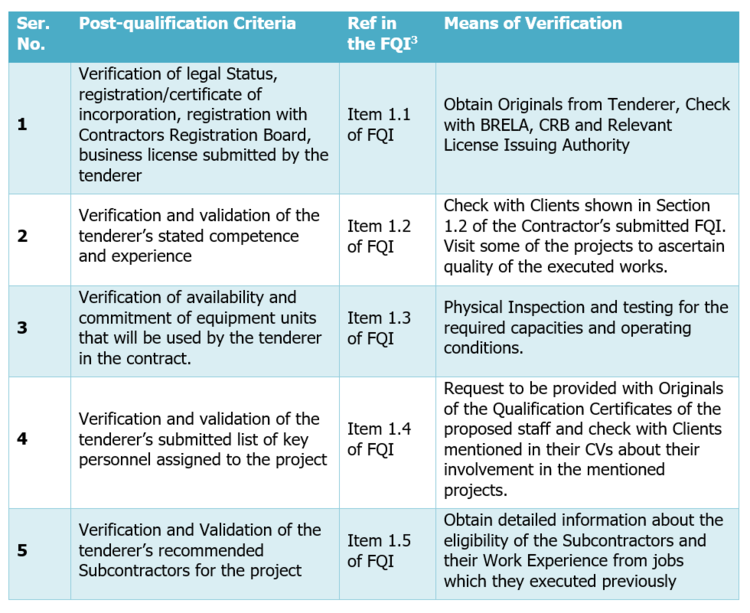
_____________________________________________
3Form of Qualification Information based on PPRA’s Standard Tender Document for Works. For other type of tender documents similar post-qualification matrix need to be developed.
